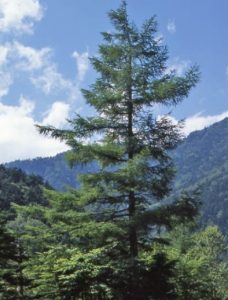
Among the plants native to Russia, there is a popular tree among the wood lover named Siberian larch or Russian larch (larix sibirica in Latin.) This tree is originally from the western Russia, close to the border between Finland and Yenisei valley of central Siberia. People have been using the wood from this beautiful Russian tree for many interior and exterior purposes – especially cladding – of many establishments due to its resistance against harsh weather. More about the tree, we will see below.
The origin of and where to find Siberian larch
When the taxonomy is involved, there are a lot of trees that fall under the family of larch and each one is a subspecies that started off with a cross between one species of larch with another depends on where it grows. Siberian larch lives in Siberia – hence the name – specifically from the eastern of Ural to the Yenisei River to the north and Irkutsk to the East. Siberian larch is the subspecies of larix sukaczewii that occupies the northern and northeastern part of European Russia.
In Russia and its neighboring countries, this subspecies of larch grows wildly in the forest across Siberia to Mongolia and northern China together with other plants. But, in several other places, Siberian larch trees are grown intentionally in plantations for the timber industry like in United States, Canada, Finland, Norway and Sweden.
The looks and characteristics
A Siberian larch tree can grow up to 50 meters tall since it is a medium to large size tree. It is also a deciduous plant which means it sheds leaves and fruits seasonally, usually during autumn, as a sign of tending and maturity. The trunk could get as big as 1 meter in diameter with upswept main branches and pendulous side branches. The leaves look like needles, are light green, and about 2 to 5 centimeters long. When it is about time to fall, the leaves will turn yellow and leave the tree bare until spring. This tree will grow faster in cold regions but also needs a full exposure to the sunlight.
This Russian tree is coniferous, which means it bears cones – like pine trees. There are male and female cones on the same tree though they are borne separately. To tell them apart, you can check the color, shape and size. Male cones are yellow, oblong, around 4 to 8 milimeters in diameter, and has wingless pollen. The female cones are green with flush of red when not mature enough, around 2 to 5 centimeters long, and will turn brown and open to release winged seeds. Old cones can stick with the tree for many years until the color turns dull and greyish. The center of the wood is reddish-brown to brick-red. The concentration of the resin in the wood is very high and the annual rings can be clearly read and seen.
The uses of Siberian larch and why it is a popular in timber industry
Larix sibirica is highly used for cladding. What is cladding? It is the process of layering the exterior of a building by applying one material over another to create thermal insulation and protection from the weather besides giving a plus point to the appearance of the establishment. Cladding also provides good soundproof system. Siberian larch is a favorite choice for cladding mainly because of its beautiful color and texture due to the clear annual rings. Another reason is because the high density of the wood makes it last a long time, very durable, and great for the exterior part of a building as well as flooring and decking. This Russian tree produces wood that doesn’t easily get knocked, scraped, or scratched – making it perfect for cladding.
The high level of resin in the wood prevents it from getting rotten or destroyed from the inside easily. This is why Siberian larch is an excellent choice for poles, posts, railroad tie sleepers, and props for mining roof. Many velodromes around the world, including the Manchester Velodrome in England and Velodrome Krylatskoye in Moscow, also use the wood from this Russian tree to surface the tracks. Another interesting fact about the Siberian larch is that the resin could be used as the natural chewing gum that you can find commercially produced in Russia and being sold in stores. It is one of Russia’s traditional products that don’t use any preservatives, artificial sweeteners, or chemical. Very interesting.
The maintenance and treatment of Siberian larch cladding
Other than resin, the Russian larch is also rich with other natural properties which make it easy to maintain. The wood is naturally protected from decay and rot, also the density indicates that it doesn’t require much treatment. However, no matter how sturdy a cladding wood is, it still needs to be taken care of to increase its lifetime. When used in regions with harsh environmental conditions – rough winters and strong summers – the Siberian larch wood needs extra protection from UV and water so it won’t get weathered too fast.
It is true that everything from the nature will change over time; weathered and degraded. But, just like how humans trying to slow down the process of themselves getting old, wood needs the same treatment. With effective protection, the withering can be controlled and limited and so the timber will last a long time in great condition. Also protection against fungal and pests should be considered as well to maintain the color and appearance of the wood.
That was the brief explanations about Siberian larch, the beautiful Russian tree popular for cladding around the world also about what cladding means and is for. If you are one of the people who appreciate living close to nature and love having natural material around the house, then this type of wood is definitely one you should consider to keep your house protected as well as looking good.
